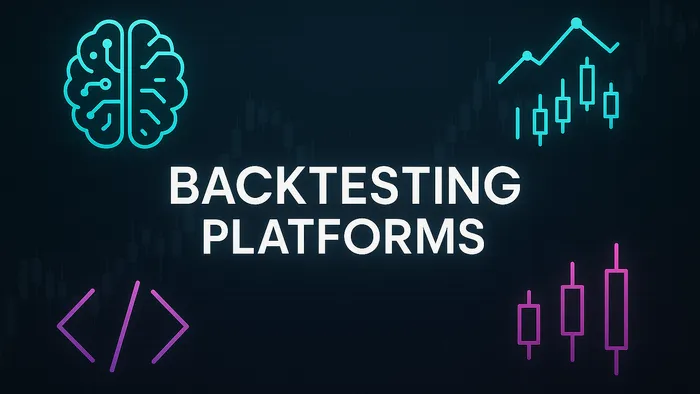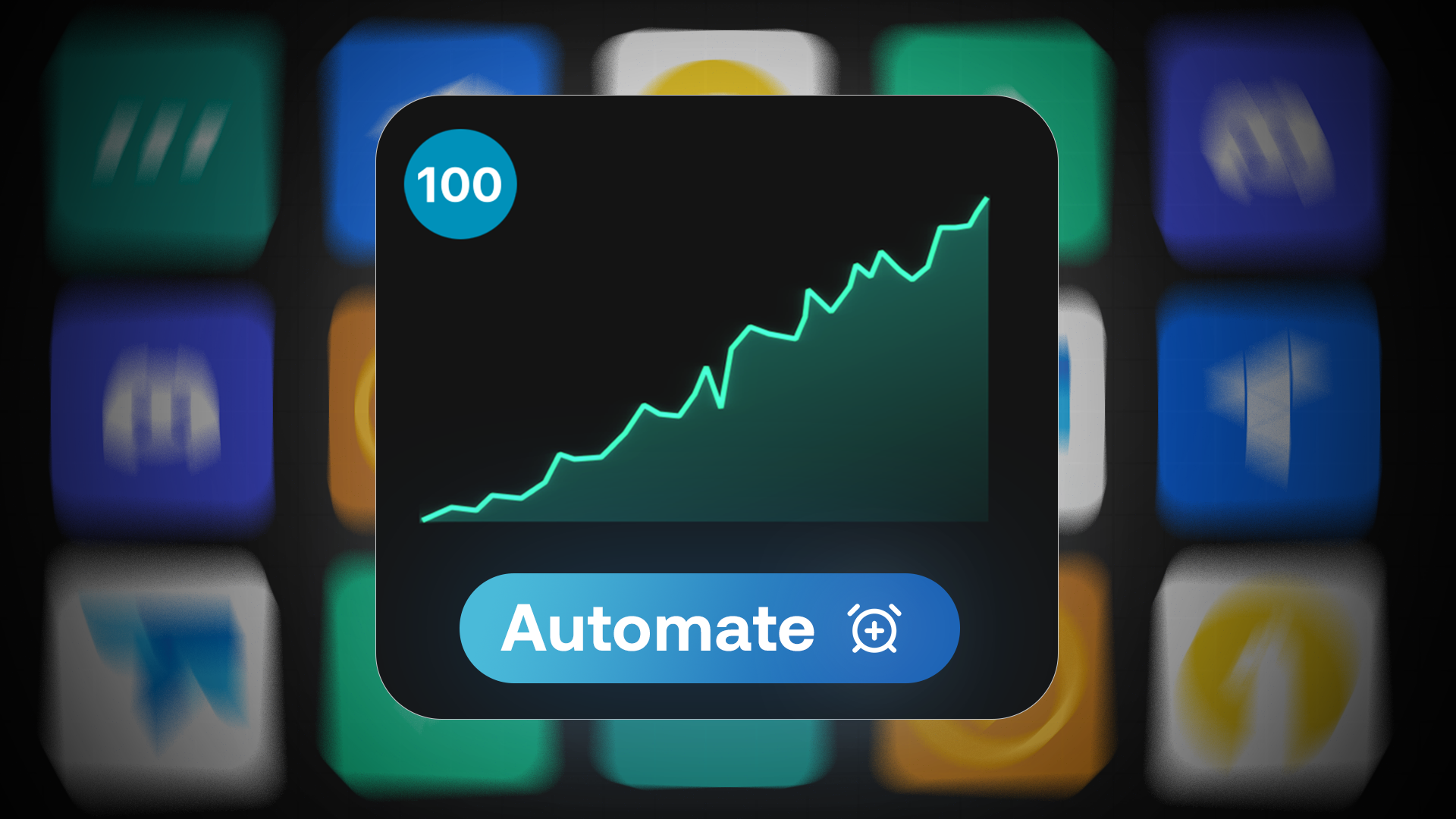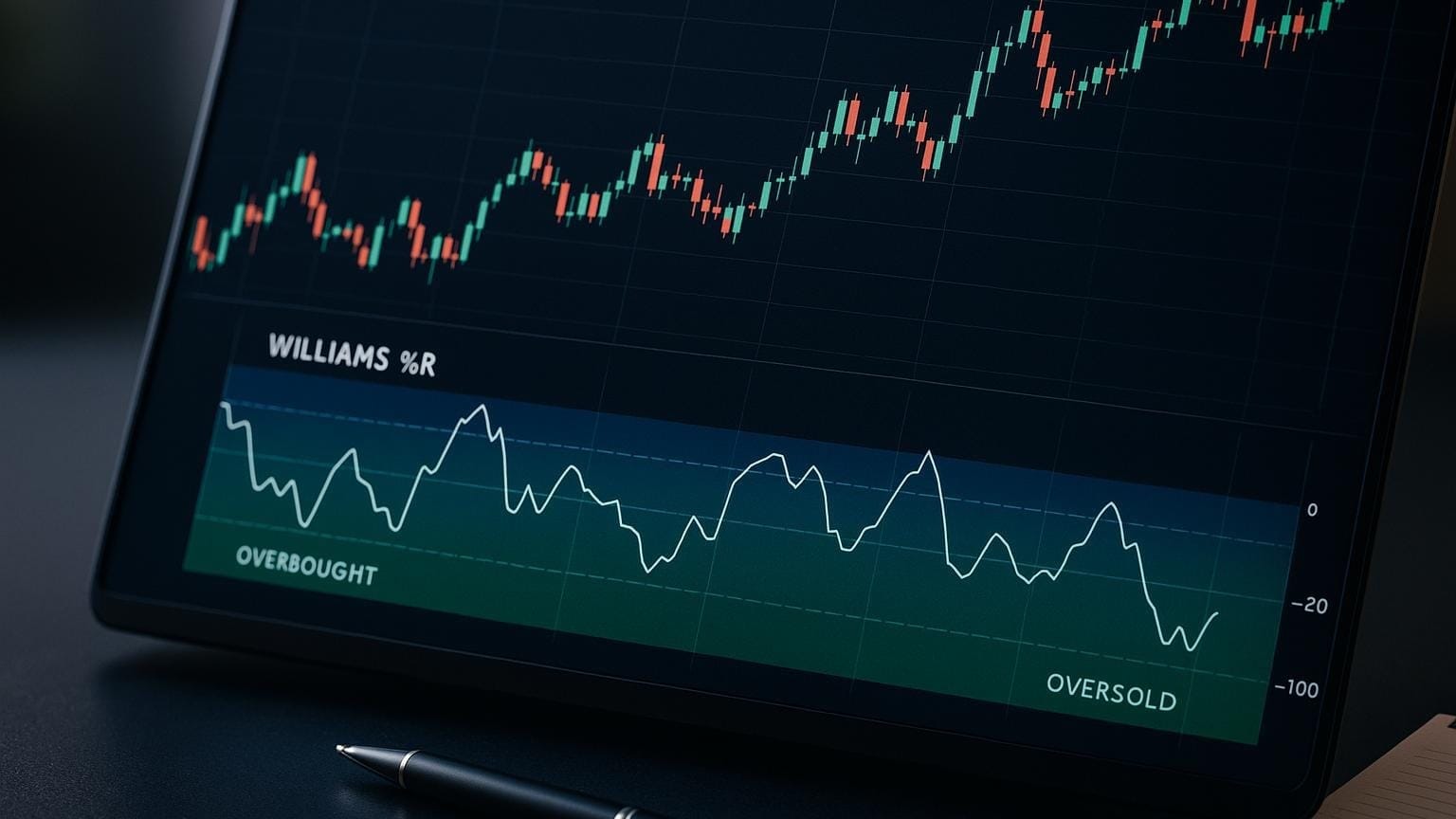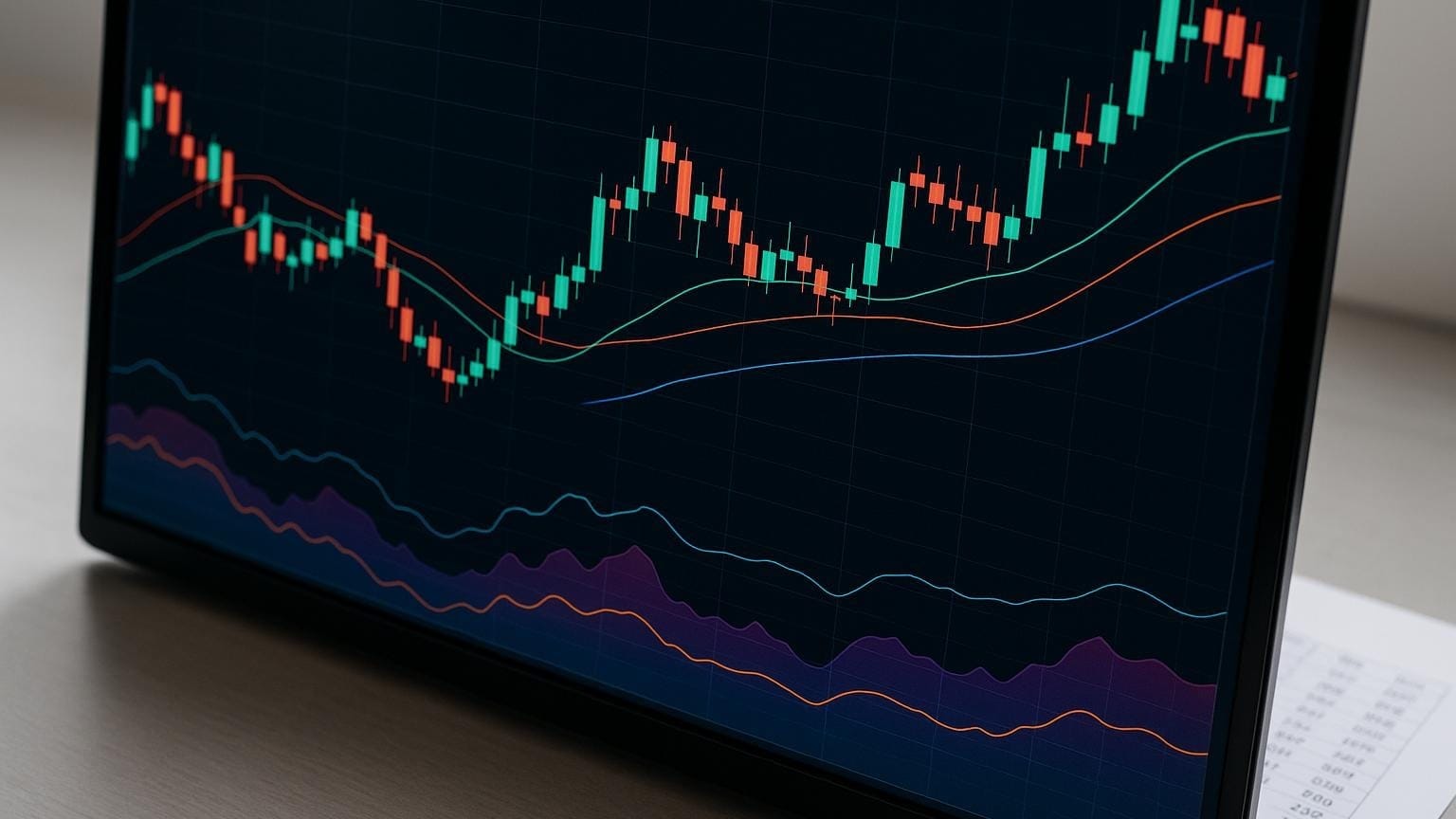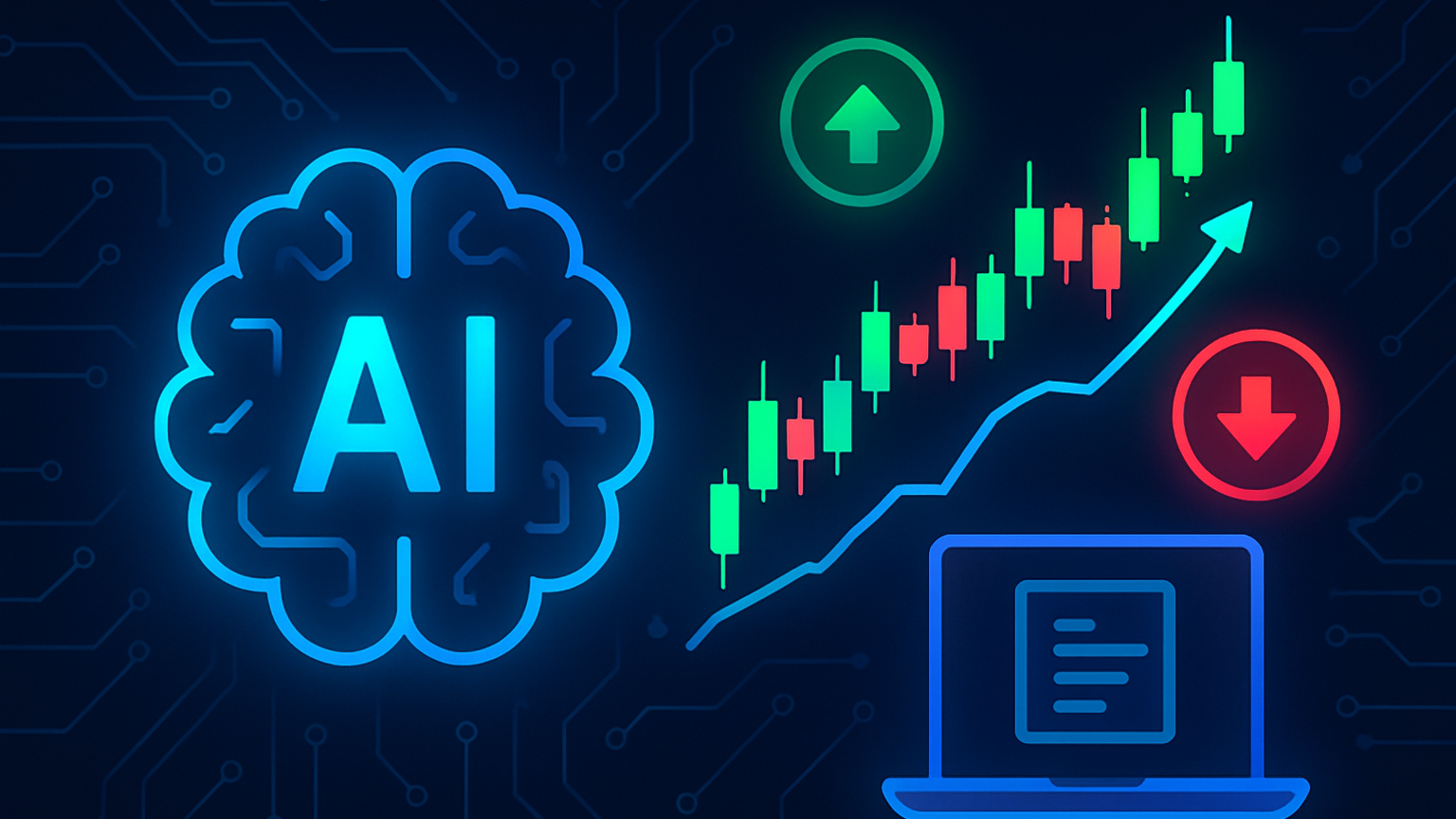Explore top backtesting software for retail quants, comparing features, costs, and usability to enhance your trading strategies.
Backtesting tools help retail quants test trading strategies using historical market data without risking real money. This article ranks eight platforms based on criteria like data quality, cost modeling, performance metrics, ease of use, and market coverage. Here's a quick summary:
- TrendSpider: No coding required, 50 years of data, but lacks slippage and commission modeling.
- TradingView: Pine Script for strategy creation, broad market data, but no custom data uploads.
- Trade Ideas: AI-driven backtesting, limited to 64 days of historical data.
- Backtrader: Open-source Python framework, ideal for coders but requires technical skills.
- QuantConnect: Cloud-based, supports Python and C#, advanced cost modeling.
- TraderEdge: Combines backtesting and journaling, fast but challenging for beginners.
- LuxAlgo: AI Backtesting platform and exclusive trading toolkits, integrates seamlessly with major charting platforms.
- MetaTrader 5: Popular for Forex, offers multi-currency testing and genetic optimization.
Quick Comparison
| Platform | Coding Required | Key Features | Starting Cost (Annual) |
|---|---|---|---|
| TrendSpider | No | AI Strategy Lab, 50 years of data | $648 |
| TradingView | Yes (Pine Script) | Extensive market data, community scripts | $167.88 |
| Trade Ideas | No | AI-powered backtesting | $1,068 |
| Backtrader | Yes (Python) | Open-source, customizable | Free |
| QuantConnect | Yes (Python, C#) | Advanced cost modeling, cloud-based | Free |
| TraderEdge | No | Journaling + backtesting | $499 |
| LuxAlgo | No | AI Backtesting platform, exclusive toolkits | $0 |
| MetaTrader 5 | Yes (MQL5) | Multi-currency testing, genetic optimization | Broker-dependent |
Choose based on your skill level, budget, and trading needs. For beginners, TradingView offers ease of use. For coders, Backtrader and QuantConnect provide flexibility. Advanced users may prefer platforms like LuxAlgo or MetaTrader 5.
Best Backtesting Software: Compare Top Tools for Traders!
1. TrendSpider

TrendSpider offers powerful backtesting tools with access to 50 years of historical data. Its Strategy Tester allows traders to validate strategies across multiple asset classes without needing coding skills.
Data Coverage and Quality
TrendSpider pulls data from top-tier exchanges and institutions:
| Asset Class | Data Sources |
|---|---|
| US Stocks & ETFs | NASDAQ, NYSE, AMEX, OTC/Pinksheets, IEX |
| Cryptocurrencies | 150+ exchanges via 170+ integrations |
| Forex | 25+ international currency institutions |
| Futures | CME, NYMEX, COMEX, CBOT |
With support for over 61,000 tradable assets, it also provides extended hours data, helping users create more realistic tests. This extensive data coverage forms a solid base for developing and refining trading strategies.
Strategy Development Features
The AI Strategy Lab offers multiple ways to build strategies: through natural-language inputs, a user-friendly point-and-click interface, or JavaScript for creating custom indicators.
Practical Considerations
A key limitation is that the platform assumes perfect execution conditions, which means it doesn’t factor in slippage, broker fees, or commissions. To address this, you can use the “Trade by next” feature. This tool helps generate more realistic simulations by accounting for potential slippage.
Market Coverage
TrendSpider supports backtesting for stocks, futures, cryptocurrencies, forex, and OTC markets. Futures traders can access enhanced CME data for an extra $7.50 per month or $90 annually. However, backtesting for indices and options data is not currently available.
The platform excels at helping traders shift from discretionary to systematic trading. Its visual strategy tester simplifies complex quantitative analysis, making it approachable for users at any skill level.
2. TradingView

TradingView is a widely used platform for backtesting, with over 100 million traders and investors relying on its features.
Strategy Development Environment
The platform’s strategy development is powered by Pine Script. This scripting language allows users to create and customize strategies, drawing from a massive repository of over 10 million custom scripts.
Backtesting Features and Limitations
TradingView’s backtesting capabilities depend on the subscription plan you choose:
| Plan | Annual Cost | Backtesting Features |
|---|---|---|
| Premium | $677.88 | Standard backtesting, strategy testing |
| Expert | $1,199.40 | Deep backtesting, extended historical data |
| Ultimate | $2,399.40 | Advanced backtesting, comprehensive data access |
However, the platform has some limitations. It doesn’t support uploading custom historical data or testing multiple variables simultaneously. Despite these constraints, TradingView allows for quick strategy adjustments and benefits from its extensive market data.
Data Coverage
TradingView provides access to a broad range of market data, which enhances strategy analysis. Using Pine Script, traders can specify custom date ranges for evaluating how strategies perform under specific market conditions.
“TradingView makes it easy to backtest trading strategies. But there are things that you have to be aware of to get accurate results.” – Hugh Kimura
Best Practices for Strategy Testing
To get the most out of TradingView’s backtesting tools, keep these tips in mind:
- Focus on strategies with promising potential
- Test strategies across various market conditions
- Look for consistent performance in specific markets
- Conduct forward testing before live trading
TradingView’s high user rating of 4.9 from 1.5 million mobile reviews speaks to its reliability for strategy development and testing. Still, remember that while it excels in charting and testing, forward testing is essential before executing strategies in live markets.
3. Trade Ideas
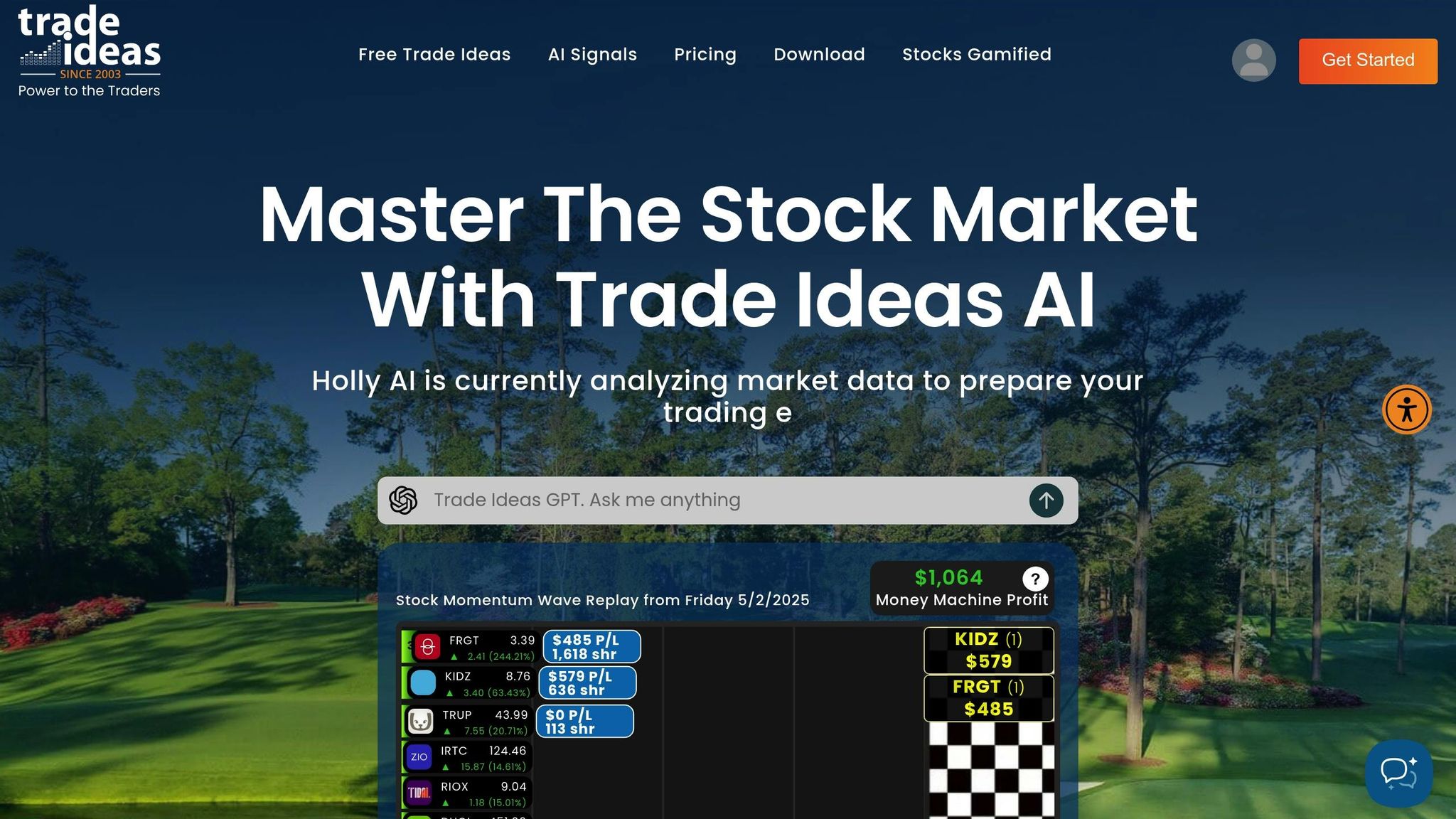
Trade Ideas is a platform that uses AI to enhance backtesting and refine trading strategies. Its Oddsmaker tool allows traders to analyze strategies based on detailed, data-driven insights.
AI-Driven Backtesting
Holly AI processes market data to deliver actionable signals, using strategies tailored to specific market scenarios.
Here are some of Holly AI’s strategies:
| Strategy Name | Price Range | Key Conditions | Target Criteria |
|---|---|---|---|
| 5 Day Bounce | Under $20 | Bounces from 5-day range lows | 60-minute high cross |
| Alpha Predator | Under $20 | Multiple timeframe green | Pullback trigger |
| Bon Shorty | $15-$85 | Resistance breakdown | Bearish SPX condition |
This AI-powered approach feeds directly into Oddsmaker’s detailed backtesting capabilities.
Oddsmaker Features
The Oddsmaker tool delivers in-depth backtesting results, including:
- High-Resolution Data: Uses 1-minute candle data for precise testing.
- Historical Depth: Analyzes up to 64 days of past data.
- Trade Volume: Evaluates up to 100 trades daily, totaling around 6,200 trades over the testing period.
These features provide traders with the insights needed for fine-tuning their strategies.
Strategy Refinement
Trade Ideas breaks down strategies into components using filter-based analysis, helping traders optimize key metrics like profit factors, win rates, and expected returns. This approach ensures strategies are both effective and easy to use.
Real-Time Adjustments
The platform continuously adjusts its scanning parameters based on historical performance. Each night, it runs backtesting simulations to refine criteria. Pre-built scans offer a starting point for strategy development, while customizable options allow for detailed adjustments. This combination of automation and manual input creates a dynamic system for developing and testing strategies, keeping them aligned with current market trends.
4. Backtrader

Backtrader is an open-source Python framework designed for retail quants who prefer a code-driven approach to creating, testing, and deploying trading strategies.
Core Framework Features
The platform uses zero-based indexing to eliminate look-ahead bias, ensuring accurate backtesting. This design also allows it to handle large datasets quickly and efficiently.
Technical Capabilities
Backtrader’s features include:
| Component | Capabilities | Benefits |
|---|---|---|
| Indicators | Over 122 built-in indicators, integrates with ta-lib | Wide range of analysis tools |
| Data Support | Supports CSV, databases, and Yahoo Finance | Flexible data input options |
| Order Types | Multiple order types, long/short positions | Comprehensive trading simulation |
| Analysis Tools | Sharpe Ratio, SQN calculations | Insightful performance metrics |
Advanced Testing Features
The platform includes a broker simulation system that supports custom slippage models and volume-filling strategies. It also automates performance plotting with matplotlib, providing clear visualizations.
Implementation Requirements
To use Backtrader, you’ll need:
- Python 2.7 or 3.2+
- matplotlib 3.2.2
- Optional: btconfig for configuration-based strategy setup
Strategy Development Tools
Backtrader includes performance analyzers, automated plotting capabilities, and tools for smart stake sizing.
Live Trading Integration
The platform supports live trading by connecting with brokers like Interactive Brokers and Oanda. This allows users to transition from backtesting to live execution with minimal code adjustments.
Practical Limitations
While Backtrader is powerful, it does have some drawbacks:
- Developing complex strategies can take significant time.
- Data feed options are limited to supported sources and brokers.
- It offers limited features for options trading, such as handling expirations or strike prices.
Backtrader is best suited for retail quants with programming experience, offering a versatile environment for building systematic trading strategies.
5. QuantConnect
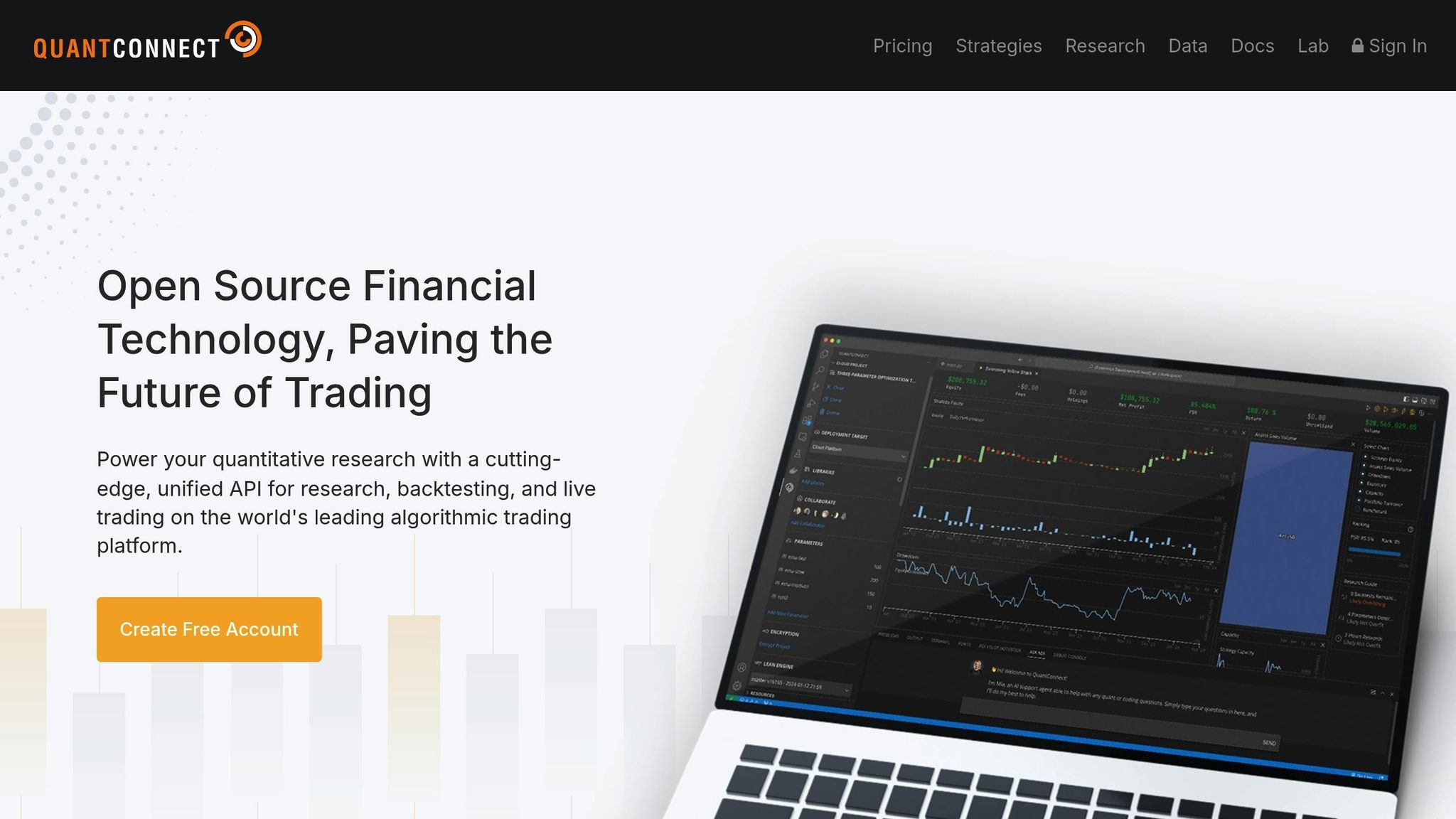
QuantConnect offers a cloud-based backtesting platform powered by its LEAN engine, designed to meet the needs of retail quants. It focuses on key aspects like data accuracy, cost modeling, and user-friendly tools. The platform provides enterprise-level infrastructure, supported by thousands of unit and regression tests.
Core Backtesting Features
| Feature | Description | Advantage |
|---|---|---|
| Point-in-Time Data | Historical data synced to specific times | Prevents look-ahead bias |
| Cost Modeling | Adjusts for fees, slippage, and spreads | Simulates realistic performance |
| Multi-Asset Support | Works with equities, forex, crypto, futures, and options | Enables diverse portfolio modeling |
| Custom Data Import | Integrates alternative data sources | Expands strategy possibilities |
Development Environment
QuantConnect supports coding in Python and C# through both a web-based IDE and a local development setup. Features like Autocomplete and Intellisense make coding more efficient. These tools lay the groundwork for advanced options, including AI-driven assistance.
AI-Powered Assistance
Mia, QuantConnect’s AI assistant, provides contextual help for coding complex strategies, making development faster and more intuitive.
Academic Integration
“In order to be able to design a viable algorithm, a robust backtesting engine is crucial. After exploring various options, we found QuantConnect to be the most suitable for our needs. Its ease of use, wide range of instruments and asset classes, and an extensive Python library makes it an ideal choice for student.” – David Ye, Professor, Duke University
Pricing Structure
| Plan | Monthly Cost | Key Features |
|---|---|---|
| Free | $0 | Basic data access, community support |
| Quant Researcher | $60 | Local coding, 2 compute nodes |
| Team | $120/user | Collaboration tools, 10 compute nodes |
| Trading Firm | $336/user | Team ownership, unlimited compute nodes |
| Institution | $1,080/user | On-premise deployment, AES-256 encryption |
Community and Support
QuantConnect boasts a community of 374,200 quants, researchers, and engineers. Each month, users develop 2,500 new algorithms and write 1 million lines of code.
Professional Implementation
“As a quantitative algorithmic hedge fund, we were seeking a platform that would enhance our ability to develop and backtest our trading strategies. After evaluating a range of solutions, we wholeheartedly endorse QuantConnect as the ideal platform for our needs.” – Chris O’Donnel, OAMQuant Co-Founder
6. TraderEdge

TraderEdge combines backtesting and journaling into a single platform, making it easier to validate trading strategies. It stands out with its manual, replay, and automated testing options, offering speed and flexibility for traders.
Core Features and Asset Coverage
TraderEdge supports various asset classes, including forex, cryptocurrencies, stocks, and futures, allowing users to test strategies across multiple markets. Its EdgeScore goes beyond simple profit/loss metrics, providing a more detailed assessment of strategy performance.
Testing Options
| Mode | Purpose | Benefits |
|---|---|---|
| Manual | Analyze individual trades | Refines entry/exit decisions |
| Replay | Simulate past market data | Validates decision-making |
| Automated | Test strategies at scale | Ensures efficiency |
Performance Tracking
TraderEdge allows users to save an unlimited number of backtests. Its automated tracking tools monitor strategy progress, compare results, and highlight trade patterns. According to reports, backtesting with TraderEdge is up to three times faster than using spreadsheets.
Pricing Plans
| Plan Type | Cost |
|---|---|
| Monthly | $50 |
| Annual | $499 |
| Data Guru | $39/month |
| Professional | $9,990/year |
Things to Keep in Mind
The platform can be challenging to master, especially its automated features. Combining replay mode with manual testing often yields the best results for refining strategies.
Integrated Tools
TraderEdge simplifies the workflow by combining journaling and backtesting into one interface. This setup ensures a smoother transition from testing strategies to executing them live, eliminating the need for separate tools and streamlining the entire process.
7. LuxAlgo
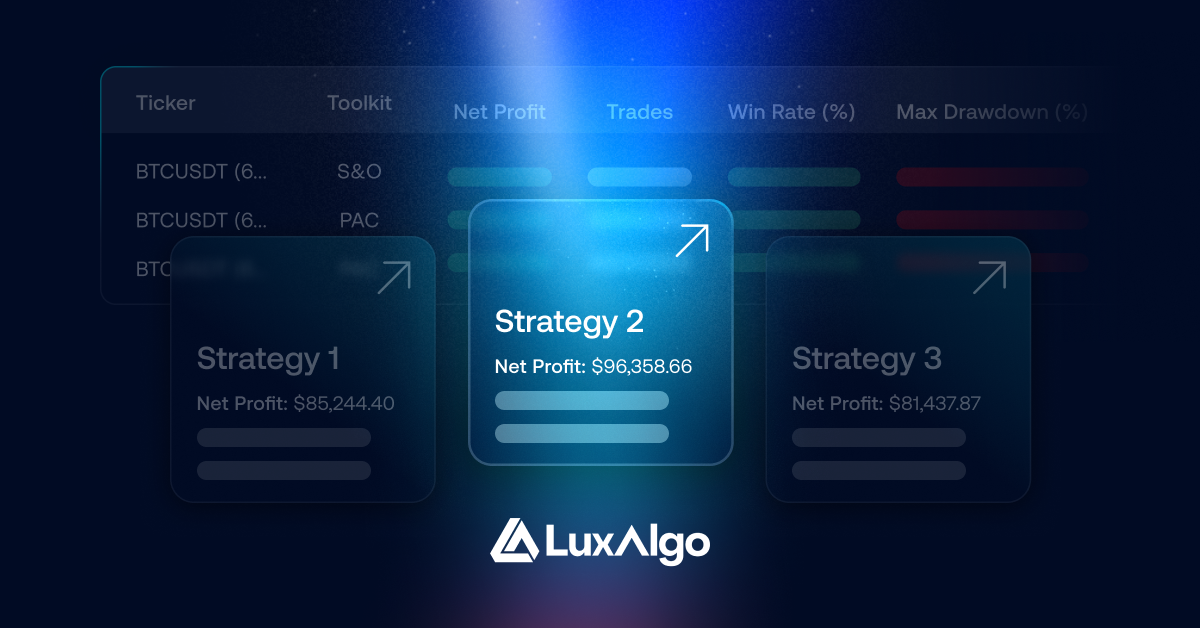
LuxAlgo provides exclusive trading toolkits on TradingView and an AI Backtesting platform that automatically designs and evaluates millions of strategies. With a community of over 15,000 traders and more than 6 million AI-driven strategies generated, it offers a solid foundation for systematic analysis.
Core Backtesting Features
LuxAlgo includes three key backtesting components, each designed to address specific aspects of trading analysis:
| Component | Purpose | Key Features |
|---|---|---|
| PAC Backtester | Tests price action strategies | Detects patterns, performs volumetric analysis |
| S&O Backtester | Validates trading signals | Combines multiple algorithms, offers overlay visualization |
| OSC Backtester | Focuses on oscillators | Identifies divergences, provides trend signals |
AI Backtesting Assistant
The AI Backtesting Assistant automatically adjusts parameters, tests strategies across different market scenarios, delivers performance insights, and pinpoints setups with high potential.
Customization Options
LuxAlgo offers several ways to tailor strategies and alerts to individual trading styles:
| Feature | Capability |
|---|---|
| Custom Alert Creator | Set up personalized notifications |
| Alert Scripting | Automate alerts for strategies |
| Deep Optimization Engine | Fine-tune signal parameters |
| Scanner Integration | Filter markets based on specific criteria |
Pricing Structure
| Plan | Monthly | Annual |
|---|---|---|
| Free | $0 | $0 |
| Premium | $39.99 | $479.88 |
| Ultimate | $59.99 | $719.88 |
Platform Integration
LuxAlgo connects with major charting platforms, enabling traders to test and execute strategies without needing to switch between tools. Every plan includes a 30-day money-back guarantee, giving traders time to explore the features and decide if the service meets their needs.
8. MetaTrader 5

MetaTrader 5 is a popular tool among retail quants, offering an integrated tester for backtesting trading robots. It uses historical market data and provides multiple testing modes to suit different analysis needs.
Testing Modes and Accuracy
MetaTrader 5 offers three testing modes, each balancing speed and precision differently:
| Testing Mode | Speed | Accuracy | Best For |
|---|---|---|---|
| Every Tick | Slow | Highest | Final strategy validation |
| 1-minute OHLC | Medium | Moderate | Initial optimization |
| Open Prices Only | Fast | Basic | Quick estimations |
The “Every Tick” mode provides the most precise results, using actual exchange data for testing.
Advanced Testing Features
Beyond mode selection, MetaTrader 5 includes features designed to strengthen strategy validation:
| Feature | Purpose | Benefit |
|---|---|---|
| Multi-currency Testing | Analyze multiple instruments at once | Spot cross-market correlations |
| Forward Testing | Split data for optimization and validation | Avoid over-optimization |
| Visual Testing | Observe Expert Advisor operations in real-time | Understand strategy behavior |
| MQL5 Cloud Network | Use distributed computing for optimization | Speeds up the testing process |
Optimization Capabilities
MetaTrader 5 uses genetic algorithms to evaluate thousands of parameter combinations efficiently.
To boost testing accuracy, consider these technical tips:
- Download complete historical data for accurate simulations.
- Use
Sleep()for proper bar synchronization. - Add
IndicatorRelease()inOnDeinit()to free resources. - Account for spread variations during testing.
The platform also pre-calculates indicators before each event, ensuring signals are generated accurately.
Platform Comparison
This section examines the key features, capabilities, and limitations of popular backtesting platforms.
Core Features and Capabilities
| Feature | TradingView | QuantConnect | MetaTrader 5 | Backtrader |
|---|---|---|---|---|
| Programming Language | Pine Script | Python, C# | MQL5 | Python |
| Data Coverage | Broad market data from millions of users | Multiple asset classes | Focus on Forex and CFDs | User-provided data |
| Testing Speed | Browser-based | Cloud-based | Multiple modes | Python-based |
| Execution Modeling | Basic | Advanced | Comprehensive | Customizable |
| Community Size | 90M+ users | 374,200+ quants | Extensive | Active developers |
Pricing Structure and Accessibility
| Platform | Annual Cost Range | Trial Period | Key Features |
|---|---|---|---|
| TradingView | $167.88 – $2,399.40 | 30 days | Browser-based, cloud storage |
| TrendSpider | $648 – $2,388 | None | AI-powered analysis |
| MetaTrader 5 | Broker-dependent | Demo available | Integrated broker support |
| QuantConnect | Processing-based | Free tier available | Enterprise infrastructure |
Now, let’s dive deeper into the technical aspects that set these platforms apart.
Technical Considerations
Beyond features and pricing, technical factors are critical when choosing a backtesting platform.
- Data Quality and Coverage
Accurate historical data is essential for reliable backtesting. Platforms with diverse asset class coverage allow for more thorough strategy testing. - Execution Model Accuracy
Execution accuracy can vary by market type and conditions. Here’s a breakdown:Market Type Typical Slippage Stress Scenario Large-cap Stocks 0.01–0.05% 0.1–0.2% Major Forex Pairs 0.1–0.3% 0.5–1.0% Major Cryptocurrencies 0.1–0.5% 1.0–5.0% - Development Environment
Each platform offers unique development tools:- TradingView: Simplified Pine Script with extensive documentation.
- QuantConnect: Advanced Python and C# environment for professionals.
- Backtrader: Python-based framework with event-driven architecture.
- MetaTrader 5: MQL5 language paired with built-in optimization features.
This overview highlights how each platform’s tools and features align with different trading requirements, providing options tailored to various needs.
Summary and Recommendations
Let’s connect the key features of these platforms to the specific needs of different types of traders.
For Beginners and Non-Coders
TradingView is a great starting point thanks to its user-friendly design and broad market coverage. With its Pine Script environment and community-driven tools, it’s well-suited for those just beginning their journey into quantitative trading.
For Advanced Users
QuantConnect stands out for experienced traders, offering robust infrastructure, Python and C# support, and advanced backtesting tools. Its cloud-based setup and extensive data access make it perfect for developing complex strategies.
Platform Recommendations by Budget
| Budget Level | Recommended Platform | Annual Cost | Ideal For |
|---|---|---|---|
| Entry-Level | TradingView | $167.88 | Browser-based analysis |
| Mid-Range | TrendSpider | $648 | AI-powered analysis |
| Professional | LuxAlgo | $719.88 | Advanced strategy testing |
These suggestions are based on balancing costs with the features and capabilities highlighted in our analysis.
Key Factors to Consider
When choosing a platform, focus on these critical aspects:
- Data Coverage: Ensure the platform provides detailed historical data for your target markets.
- Technical Requirements: Match the platform’s complexity with your coding and technical skills.
- Integration: Check if the platform fits seamlessly into your current trading workflow.
“When backtesting futures, accuracy is everything. A good platform should simulate real market conditions, including commissions, slippage, and margin requirements.” – Andrew Rul Trading
Pick a platform that aligns with your trading style, market interests, and skill level. Starting with simpler platforms and upgrading as your skills grow is often a smart approach.
FAQs
What should I look for in a backtesting platform to optimize my trading strategy?
When choosing a backtesting platform, focus on a few critical factors to ensure it meets your needs. First, high-quality and reliable historical data is essential for accurate testing, especially if your strategy relies on long-term trends. Make sure the platform provides sufficient data depth to simulate real-world scenarios effectively.
Next, consider how well the platform accounts for real trading conditions, such as variable spreads, slippage, and commissions. These factors can significantly impact your strategy’s profitability and should be reflected in your backtests. Finally, ensure you can test your strategy across varied market conditions, including different trends, volatility levels, and major economic events, to assess its robustness and adaptability.
By focusing on these aspects, you can select a platform that supports reliable and actionable insights for your data-driven trading workflow.
What should retail quants consider when evaluating backtesting platforms for ease of use and technical requirements?
When evaluating backtesting platforms, retail quants should focus on ease of use and technical requirements to ensure the tool aligns with their skill level and trading goals. Some platforms are designed with user-friendly interfaces and require minimal coding knowledge, making them accessible for beginners. Others cater to more advanced users, offering extensive customization and requiring proficiency in programming languages like Python or R.
It’s essential to assess your own technical expertise and trading needs before selecting a platform. Look for features such as intuitive workflows, clear documentation, and compatibility with your preferred data sources and strategies. Ultimately, the right platform should streamline your backtesting process and support your quantitative trading objectives effectively.
Why are data quality and coverage essential for backtesting, and how do they influence the accuracy of trading strategy results?
High-quality and comprehensive data are critical for accurate backtesting because they directly impact the reliability of your trading strategy’s performance evaluation. Poor data quality such as missing price points, incorrect volume figures, or inaccurate timestamps can lead to flawed results and misinformed decisions.
Complete data coverage ensures that all relevant market scenarios, including rare events, are included in your tests. This helps create a more realistic simulation of how your strategy would perform in live trading. To ensure accuracy, it’s important to use reliable data sources and validate your data to minimize errors and biases.


